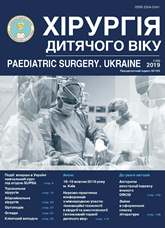Case of duodenal obstruction caused by a giant echinococcal cyst of the liver
DOI:
https://doi.org/10.15574/PS.2019.63.97Keywords:
hydatid cyst, fenestration of cysts, pericystectomyAbstract
Echinococcosis is one of the most common parasitic diseases in humans. Most of the literature reviews and reports indicate an increase in the incidence of liver echinococcosis, a significant spread of pathology beyond endemic regions, and an increase in the incidence of new cases in non-endemic areas, with 75% of cases being children and individuals and young people, children under the age of 14 account for about 15% of cases in the structure of the general morbidity of echinococcosis. Reducing parasitic morbidity, especially among children, is an essential reserve for reducing the burden of illness and prolonging life expectancy. In the majority of cases, the liver is affected – 75%, lungs – 15%; in rare cases, the brain, bones and heart (2%), kidneys (2%), skin, spleen (6%). In endemic areas, 10–15% of patients have a parasitic lesion of two organs. During the last 20 years there has been an increase in the number of complicated forms of echinococcosis in the liver, with a frequency of 84.6%. Relapse of the disease is observed in 54% of cases. Despite significant progress in the diagnosis and treatment of the disease, the frequency remains high before and after the surgical complications, the rate of relapse of the disease reaches 54%, in some regions it reaches an index of 38.8%. Modern diagnostic methods allow with high precision to carry out laboratory verification of the disease, topical distribution and morphological changes in the affected organs. In treatment, depending on the stage of the disease, the size of the parasitic cysts are used different methods: mininvasive (percutaneous puncture-aspiration echinococcectomy under the control of ultrasound or CT, Videotraco and video-laparoscopic interference), traditional echino cocectomy, pericisectomy, resection of the liver. Issues of differential diagnosis of echinococcosis, studying the possibilities of modern visualization methods in planning the volume of surgical intervention on the liver are relevant. It requires separate study of the choice of the optimal method of surgical intervention, the method of its implementation, the place and the possibilities of using mininavazivnyh techniques. The article presents the clinical case of a giant echinococcal cyst that caused acute duodenal obstruction. The description of such clinical cases in the available literature is not found.References
Nishanov F. N., Nishanov M. F., Re, A. K., Otakuziev A. Z. (2011). Etiopathogenetic aspects of recurrent liver echinococcosis and its diagnosis. Grekov's Bulletin of Surgery. 2: 91–94.
Lioyd JB. (2014). Hepatic cystic echinococcosis. The Journal of the American Osteopathic Association. 6: 505. https://doi.org/10.7556/jaoa.2014.069; PMid:24917638
Mahmoudvand H et al. (2014). In vitro lethal effects of various extracts of Nigella sativa seed on hydatid cyst protoscoleces. Iranian journal of basic medical sciences. 12: 1001–1006.
Mariconti M. (2014). Immunoblotting with human native antigen shows stage-related sensitivity in the serodiagnosis of hepatic cystic echinococcosis. The American journal of tropical medicine and hygiene. 1: 75–79. https://doi.org/10.4269/ajtmh.13-0341; PMid:24297816 PMCid:PMC3886432
Mitrea IL et al. (2014). Occurrence and genetic characterization of Echinococcus granulosus in naturally infected adult sheep and cattle in Romania Veterinary parasitology. 4: 159–166. https://doi.org/10.1016/j.vetpar.2014.10.028; PMid:25468017
Nagarajan K, Sekar D, Vijaya J, Kamath BА (2013). Hydatid Cyst of the Liver Causing Inferior Vena Caval Obstruction Journal of the association of physicians of Іndia. September: 61.
Pakala T, Molina M, George YWu. (2016). Hepatic Echinococcal Cysts: A Review. Journal of Clinical and Translational Hepatology. 4: 39–46. https://doi.org/10.14218/JCTH.2015.00036; PMid:27047771 PMCid:PMC4807142
Pektas B. (2014). Evaluation of the diagnostic value of the ELISA tests developed by using EgHF, Em2 and EmII/3-10 antigens in the serological diagnosis of alveolar echinococcosis. Mikrobiyoloji bulteni. 3: 461–468. https://doi.org/10.5578/mb.7742; PMid:25052112
Тurgut AT, Levent A, Salih T, Bulent K, Tamer A, Erkan K, Alp K, Ugur K. (2016). Unusual imaging characteristics of complicated hydatid disease. Eur J Radiol. 63: 84–93. https://doi.org/10.1016/j.ejrad.2007.01.001; PMid:17275238
Downloads
Issue
Section
License
The policy of the Journal “PAEDIATRIC SURGERY. UKRAINE” is compatible with the vast majority of funders' of open access and self-archiving policies. The journal provides immediate open access route being convinced that everyone – not only scientists - can benefit from research results, and publishes articles exclusively under open access distribution, with a Creative Commons Attribution-Noncommercial 4.0 international license(СС BY-NC).
Authors transfer the copyright to the Journal “PAEDIATRIC SURGERY.UKRAINE” when the manuscript is accepted for publication. Authors declare that this manuscript has not been published nor is under simultaneous consideration for publication elsewhere. After publication, the articles become freely available on-line to the public.
Readers have the right to use, distribute, and reproduce articles in any medium, provided the articles and the journal are properly cited.
The use of published materials for commercial purposes is strongly prohibited.

